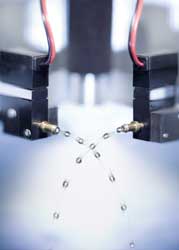
Posted to News on 25th Nov 2009, 10:13
Compact flipper isolation valve delivers improved performance
Isolated miniature solenoid valves (IMSV) that provide maximum power from a minimum sized envelope are in demand from original equipment manufacturers (OEMs) in the field of laboratory and analysis technology, and also medical engineering. In clinical diagnostics, flow rate and reliability are essential, while cleanliness is also a priority. In automated analytics, standard procedures such as titration, defined sampling and the precise dosage of reagents, based on integrated fluid control systems, require pinpoint precision and repeatability. In addition, manufacturers and users, when opting for a certain type of IMSV, also consider cost, wetted material type, cleanability, dosage capacity and flushing characteristics of the valve.

Until recently the operating principle of rocker valves - as introduced by German manufacturer, Brkert, in the early 1990s - had been considered state-of-the-art in valve technology. It set the standard for most miniature valves, especially with IVD devices, and has been copied many times. Owing to their diaphragm operation, rocker valves can process very small volumes and are easy to rinse. This has made them popular for in vitro diagnostic applications. However, since diaphragms react with a certain deceleration, rocker valves are less suitable for high-speed or high-precision applications.
This is not the case with flipper valves; they have no diaphragm, so the pumping effect at the outlet of the valve is almost completely excluded - which is an advantage when high-precision dosing is needed. They are also suitable for small volumes, working quickly and being more durable than rocker valves with their sensitive diaphragm. However, due to their particular design, flipper valves usually have a larger internal volume than comparable valves based on diaphragm technology. This increased volume and the cleanability aspect of the valves have, so far, been considered as the biggest disadvantages of flipper technology.
Eliminating the disadvantages
Despite its disadvantages, Brkert did not give up on the flipper valve - even though the company had developed its more successful competitor. Instead, Brkert sought to eliminate all the known problems with the technology. With the help of advanced digital R&D tools, researchers were successful in developing alternatives to the existing construction principles of flipper valves. Brkert's engineers used computer simulations of flows and pressure paths and applied the finite element method (FEM) to optimise their designs.
The FEM calculations supported the design of the body of the valve so as to avoid residues that are typical in contaminated systems. Different mouldings were tested and the position of the valve seats was also iteratively defined. The resulting optimised internal design enables effective flushing of media through the device in a way that was only previously possible with rocker valves. This eliminates the waste of expensive reagents, as well as preventing cross contamination and increasing process safety.
The flushing characteristics of the second-generation flipper valve are related not only to the valve's internal volume, but more principally to its internal design. This becomes clear when comparing Brkert's Type 0127 rocker valve with the company's new Type 6650 flipper isolation valve. The internal volume of the Type 6650 valve is two times smaller than the rocker valve's volume. Moreover, the 6650 is only 4.5mm wide - which is much smaller than previous models - yet it delivers greatly improved flow rates. The major advantage of this size reduction is that equipment and instrument manufacturers can pack more valves into the same space for greater functionality. This provides savings in laboratory costs, as equipment and instrument sizes can be reduced.
In addition to its size advantages, Burkert's second-generation flipper valve also delivers improved performance. The valves have short - and reliable - response times, and have high repeatability and excellent flushing characteristics. These advantages - combined with the valve's reduced size - mean that the 6650 valves are particularly suitable for the handling of liquids with micro plates where high-precision dispensing and small dimensions are required.
More About the Type 6650 Valve
The Type 6650 is the latest addition to Burkert's MicroFluidic range of products for analytical, medical and biotechnical applications. The range includes miniature solenoid valves and micropumps for applications with neutral, aggressive and highly purified media. These products are extremely proficient in the handling of fluids where internal volume, chemical resistance, precision and a lack of dead legs are paramount.
Providing high fluid control performance in a small space, Burkert says its Type 6650 sets a new standard for miniature solenoid valves employed in clinical, life science, analytical and fluid handling equipment. Suitable for use on vacuum up to 7bar, and providing medium isolation for aggressive fluids, the direct-acting Type 6650 is just 4.5mm wide yet is claimed to outperform comparable 10mm and 16mm designs.
The Type 6650 is suitable for manufacturers with valve applications requiring fast response times, high reproducibility, zero pumping and excellent flushing characteristics. The valve's optimised design ensures reproducible and precise dosing, effective rinsing capability, and can be used with aggressive chemicals.
Key to the performance of the Type 6650 valve is Brkert's patented Flipper Technology. This employs an elastomer element that moves between two opposite valve seats under the force of permanent magnets fixed to the flipper element, opening one as it closes the other. This operation requires only a temporary pulse, so is characterised by its short response time. It also provides benefits in terms of high reliability and very low levels of wear.
With the two nominal orifice sizes of 0.4mm and 0.8mm available, and both 2/2 and 3/2 functionality, the Type 6650 is useful for applications where high fluid performance is required in a small space - in dosing, for example where the Type 6650 opens up new possibilities, in particular in connection with 384-well Microtiter plates.
Use the form on this page to request more information.
Want the latest machine building news straight to your inbox? Become a MachineBuilding member for free today >>
Fluid Control Centre
1 Bridge End
GL7 1QY
UNITED KINGDOM
+44 (0)1285 648720

















